
Just for kicks I tried installing OS/2 1.3 EE on a true blue machine, an IBM PS/2 model 9577. For those few of you who don't know IBM model numbers by heart, that's a 486DX/2-66 with 8MB RAM and a 400MB SCSI harddrive. It naturally sports the Microchannel (MCA) bus and is equipped with a 1MB XGA-2 display adapter. I had to update some device drivers with a version from the latest 1.3 fixpacks but apart from that minor annoyance OS/2 1.3 had no problem working with MCA, SCSI and all that.
IBM OS/2 1.3 EE came on 19 3.5" HD floppies. That's a lot considering that back in 1991 I thought anything that came on more than 5 floppies was pretty darn big. After booting from the first floppy (OS/2 1.3 could be booted to command line from a single HD floppy, including HPFS and all) the users were greeter by a familiar blue screen - but not that kind of blue screen Windows made so popular:

After feeding all those floppies into the machine and rebooting (only one reboot was needed), the OS/2 1.3 desktop appeared. It looked pretty much the same as the Microsoft version. The only bigger difference (apart from all the server stuff of course) was the presence of four tutorial programs for the base OS, CM, LAN Requester and Database Manager - the screenshot is from the Database Manager tutorial:
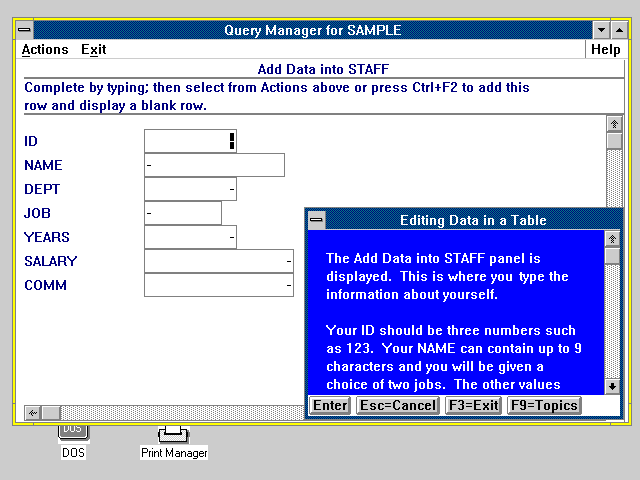
The Database Manager and base OS tutorials were graphical and Communications Manager and LAN Requester tutorials were text mode, just like the software they were explaining.
I couldn't do much with Communications Manager because the mainframes it is supposed to talk to are nearly extinct nowadays - I certainly don't know where to find one. I likewise couldn't really use the LAN Requester, this time due to a lack of device drivers. Actually, I could probably dig out a supported MCA Token-Ring adapter somewhere but I wouldn't find anything to connect to anyway. So I looked more closely at the Database Manager.
OS/2 1.3 EE came with User Profile Manager (UPM) - to use the LAN Requester or Database Manager one had to log on first:

The default user ID and password were, surprise surprise, USERID and PASSWORD. Some things don't change. That was good for me because I didn't have to dig through manuals. And if you ever wondered why the UPM interface even in the latest OS/2 versions looks so ugly and out of place, you can stop wondering right now:
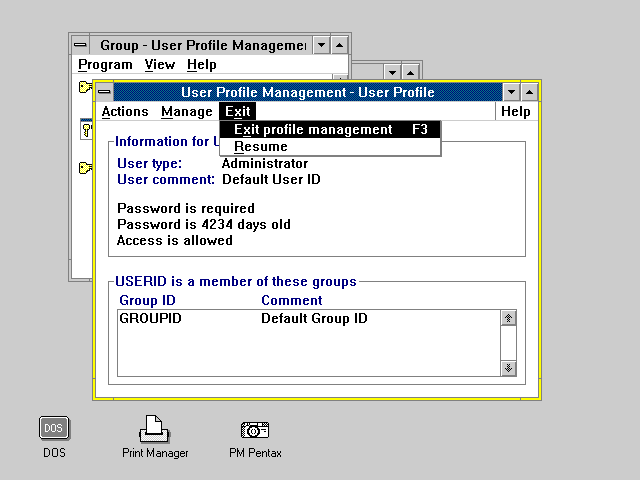
Yes, that's right. No one touched this user interface for some 10-12 years.
But back to Database Manager. Its user interface was called Query Manager.
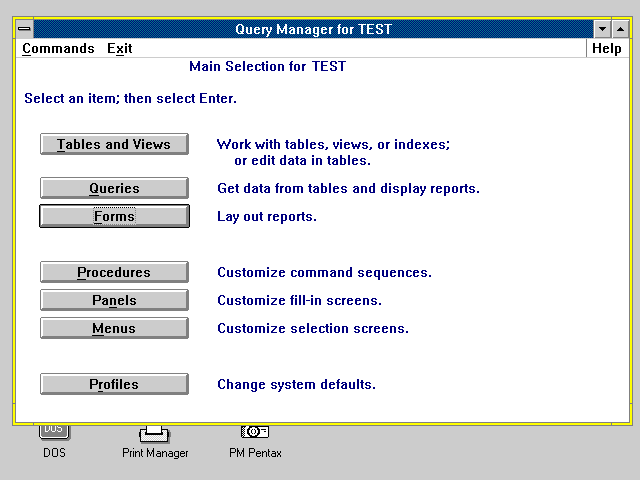
The Database Manager was a full fledged SQL database server, quite powerful. Its successor, IBM DB2/2 (and later DB2 UDB) was and still is one of the top relational database systems.
It is interesting however that the old Database Manager had more complete GUI (Query Manager) than DB2/2 later. With Query manager, users could manage tables and views, enter data, create queries and reports and so on. Here's a sample screenshot of the user interface for managing queries:

Using the Query Manager probably did not pose major difficulties to anyone with SQL experience.
OS/2 EE also came with programming headers and libraries for the EE components, enabling users to create custom applications. Some of these reportedly survived into the early third millennium, more than ten years after last 16-bit OS/2 was released.
MS LAN Manager 2.1 came on 12 floppies and contained the following:
The LAN Manager offered two interfaces: command-line based through the NET command and full-screen text mode interface which looked like this:
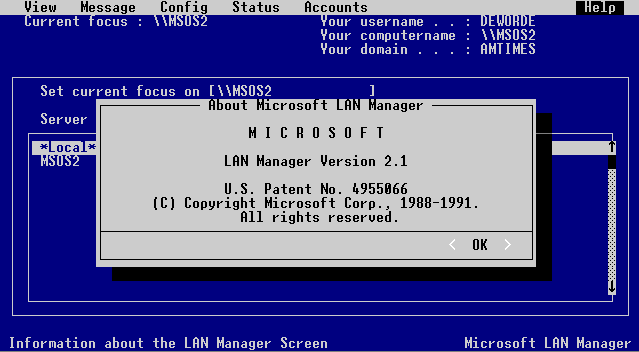
Configuration utilities for disk fault tolerance and remote boot were graphical, but those were rarely used anyway. I suspect that the text mode interface was a more or less straight port from DOS whereas the GUI utilities had no DOS counterparts.
LAN Manager used the NETBEUI protocol and also supported TCPBEUI (aka Netbios over TCP/IP). It supported a number of NICs out of the box and even today many manufacturers supply OS/2 LAN Manager drivers with their network cards - certainly the major ones like Intel or 3Com do.
LAN Manager 2.1 could do pretty much everything you'd supported a server system to do. After all, as I mentioned before, it was not all that different from today's NT server or Warp Server. It could manage domains and users, share files or printers, send messages and all that. And it already had some more advanced features such as remote booting (RIPL) of DOS and OS/2 workstations.
I briefly tried LAN Manager on our office LAN and sure enough, it still worked (there were both NT and OS/2 machines on the network). Best of all, it used a PCI 3Com Fast Etherlink XL - about 6 years newer than LAN Manager.
Compared to IBM LAN Requester, the MS LAN Manager was surprisingly poorly integrated with Presentation Manager: it didn't install any program groups or icon and didn't have any PM-based online books. Again, that's most likely because Microsoft had DOS versions of LAN Manager but IBM never produced DOS versions of LAN Server.
I am not sure when the development of OS/2 versions of LAN Manager finally
stopped but the latest version of LAN Manager client for OS/2 is version
2.2c from late 1994 - long after the MS/IBM split. It even supported OS/2
2.x. By then Microsoft was of course already pushing Windows NT as hard
as it could (though without much success initially).
SQL server 1.0 was a full-fledged RDBMS with networking support. The server ran on OS/2 1.x and clients could be OS/2, DOS or Windows 3.x. SQL Server was integrated with LAN Manager and could be operated as a LAN Manager service. It came on four 3.5" HD floppies which contained the actual server, some administration tools, client software and a development kit.
There wasn't really much to look at - most utilities were command-line only. The only somewhat more interesting utility was SAF or SQL Server Administration Facility. It looked like this:
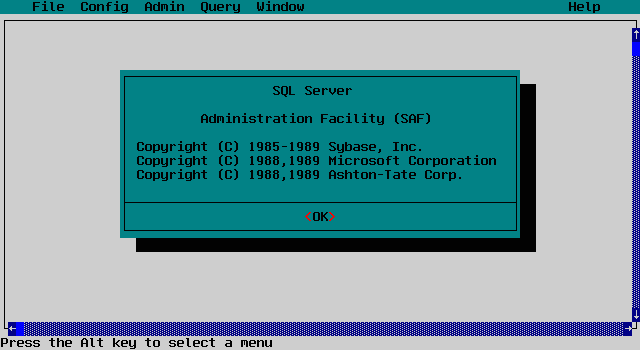
The SAF allowed administrators to do basic maintenance work (creating databases, setting up various server parameters and so on) as well as run SQL commands directly - here is a screenshot using the supplied demo database:
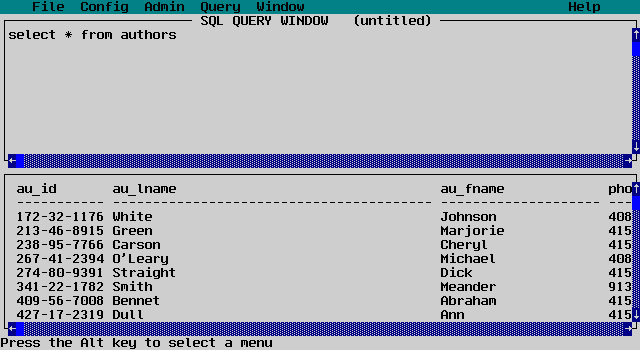
As you can see, it's plain ol' SQL... nothing out of the ordinary.
Similar to LAN Manager, the level of integration of SQL Server into OS/2 was very low. No program groups or icons were created, no online books were installed, no PM programs were provided. I must say the IBM products were much better in this respect.
When it came out, SQL Server had fairly massive hardware requirements - it needed about 30MB disk space and 10MB RAM to run smoothly. That was of course at a time when the typical machine had 1-2MB RAM and a 40MB harddrive. On today's machines however it seems pretty snappy (my test machine was a Celeron 300A with 64MB RAM and a 4GB harddrive). But SQL Server was a relatively large-scale database (for a PC anyway) so these requirements were probably justified.
I think OS/2 1.x was a much more successful as a server platform than
an end user system. Many of the server software packages available for
it have successors that are widely used today and will be for the foreseeable
future.
That's it for OS/2 1.x server software. I'm sure there was more but
this is all I could get my hands on. Perhaps I'll manage to obtain more
oldies in the future.